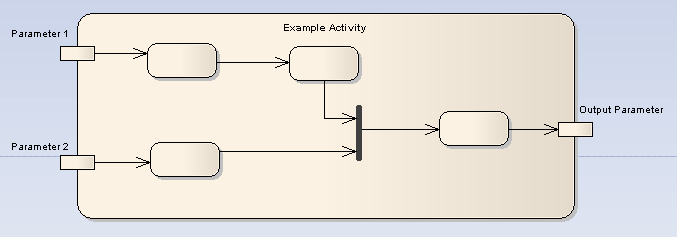
An Activity organizes and specifies the participation of subordinate behaviors, such as sub-Activities or Actions, to reflect the control and data flow of a process. Activities are used in Activity diagrams for various modeling purposes, from procedural-type application development for system design, to business process modeling of organizational structures or workflow.
The following simple diagram of an Activity contains Action elements and includes input parameters and output parameters.

You can define an Activity as a Composite element, either during creation or during later edits. However, when creating a composite Activity element you can also use the Structured Activity element, which is tailored to this purpose. If converting an Activity element, right-click on the element and select the Advanced | Composite Element context menu option. The New Structured Activity dialog displays; for information on this dialog, see the Structured Activity topic.
Toolbox Icon
![]()
OMG UML Specification
The OMG UML specification (UML Superstructure Specification, v2.1.1, p. 316) states:
"An activity specifies the coordination of executions of subordinate behaviors, using a control and data flow model. The subordinate behaviors coordinated by these models may be initiated because other behaviors in the model finish executing, because objects and data become available, or because events occur external to the flow. The flow of execution is modeled as activity nodes connected by activity edges. A node can be the execution of a subordinate behavior, such as an arithmetic computation, a call to an operation, or manipulation of object contents. Activity nodes also include flow-of-control constructs, such as synchronization, decision, and concurrency control. Activities may form invocation hierarchies invoking other activities, ultimately resolving to individual actions. In an object-oriented model, activities are usually invoked indirectly as methods bound to operations that are directly invoked.
"Activities may describe procedural computation. In this context, they are the methods corresponding to operations on classes. Activities may be applied to organizational modeling for business process engineering and workflow. In this context, events often originate from inside the system, such as the finishing of a task, but also from outside the system, such as a customer call. Activities can also be used for information system modeling to specify system level processes.
"Activities may contain actions of various kinds:
| · | Occurrences of primitive functions, such as arithmetic functions. |
| · | Invocations of behavior, such as activities. |
| · | Communication actions, such as sending of signals. |
| · | Manipulations of objects, such as reading or writing attributes or associations. |
"Actions have no further decomposition in the activity containing them. However, the execution of a single action may induce the execution of many other actions. For example, a call action invokes an operation which is implemented by an activity containing actions that execute before the call action completes."
See Also


